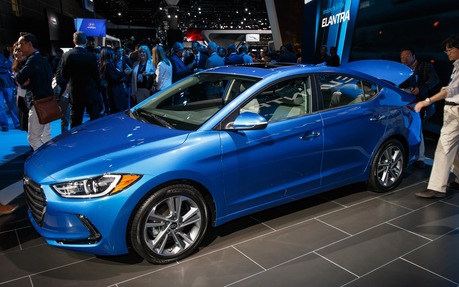2017 Hyundai Elantra: Bigger, More Rigid And Less Powerful
Hyundai unveiled the sixth generation of its popular compact car, the Elantra, at the Los Angeles Auto Show.
A product that’s been simplified, we could summarize the new Elantra like this: bigger, more rigid and less powerful. Here’s what you need to know about the 2017 Hyundai Elantra.
Revised – but conservative – styling
Hyundai isn’t taking any risks here, and doesn’t need to. As value is the main attraction of their products, there’s no point in offering a car that seeks to challenge styling conventions.
As such, the Elantra’s appearance is inspired by the Sonata’s, but adapted to its smaller frame. Up front, the hexagonal grille remains, but its rounder shape creates a less aggressive look than the outgoing car, the old Elantra being far from a squared-off car to begin with.
Just like on the Sonata, the roofline flows right down to the edge of the trunk. LED headlights can be specified, and so can 17-inch alloy wheels.
Hyundai claims the Elantra is a midsize car (which would make the Sonata a full-size sedan?). In fact, the new Elantra is longer by 2 centimetres, wider by 0.5 cm and taller by 0.5 cm.
Finally, a Hyundai cockpit
Those who are very familiar with the brand have noticed that the Sonata shares much of its interior styling with the larger Hyundai Genesis Sedan. That design is characterized by a dashboard that’s slightly slanted towards the driver, and isolated from the rest of the components.
Undeniably more luxurious than before, this sixth generation should be the category benchmark in regards to accommodations and interior design. For example, heated front seats are standard, while the rear ones can optionally be heated too.
The cockpit will notably be spacious. The larger-than-compact car pretentions are justified by the Elantra’s 3,120-litre total interior volume rating, which ranks close to the Toyota Corolla and the Honda Civic. Both of which, according to Hyundai, are midsized cars. Hold your horses.
Less power, but more rigidity
The 2017 Elantra discards the idea of offering two powertrain choices. In the 2016 edition, a 145-hp, 1.8-litre four-cylinder engine was the base unit, while customers could option up the little Hyundai with a 173-hp, 2.0-litre four.
From now on, Hyundai will concentrate on one sole engine, and a modern one at that. Called “Nu,” this 2.0L four-cylinder engine runs on an Atkinson cycle. This technology is a little difficult to grasp, but in short, Atkinson-cycle engines produce more power at lower revs than a conventional engine (that runs on an Otto cycle). In other words, it works less for an equal output, which translates into higher fuel economy.
It deploys 147 horsepower and 132 lb-ft of torque. As for gearboxes, consumers have a choice between a six-speed manual and a six-speed automatic, the latter being improved and optimized for fuel economy. The company also promises “more dynamic performance.”
If this power drop seems regrettable, the car’s chassis has been strengthened by 29.5%, which should make the car handle better.
For the rest, the car is stuffed with technological gadgets usually reserved for more upscale vehicles, such as a high-quality sound system and many collision detection and warning systems, which make the 2017 Elantra one of the most actively safe compacts in the world.
With all these new features, the Elantra will undoubtedly be an attractive proposition. All we have to do is wait for it to become available in order get a better opinion. Pricing will be announced later, likely in 2016.
- Check out our Hyundai Zone
- Check out our complete coverage of the Los Angeles Auto Show
